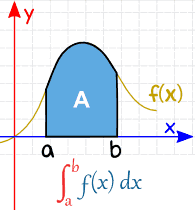If the value of \(∫_{-0.15}^{0.15} |100x^{2}-1|dx = \frac{k}{3000}\), then the value of k is?
Approach Solution - 1
The given integral is:
\( \int_{-0.15}^{0.15} |100x^2 - 1| \, dx = 2 \int_{0}^{0.15} |100x^2 - 1| \, dx \)
Step 1: Critical Point
Solve \( 100x^2 - 1 = 0 \):
\( x^2 = \frac{1}{100} \Rightarrow x = 0.1 \)
The integral splits into two parts:
\( I = 2 \left[ \int_{0}^{0.1} (1 - 100x^2) \, dx + \int_{0.1}^{0.15} (100x^2 - 1) \, dx \right] \)
Step 2: Evaluate Each Integral
1. For \( \int_{0}^{0.1} (1 - 100x^2) \, dx \):
\( \int (1 - 100x^2) \, dx = x - \frac{100}{3}x^3 \)
Evaluate:
\( \left[ x - \frac{100}{3}x^3 \right]_0^{0.1} = 0.1 - \frac{100}{3}(0.1)^3 \)
Simplify:
\( = 0.1 - \frac{100}{3} \cdot 0.001 = 0.1 - \frac{0.1}{3} = \frac{0.2}{3} \)
2. For \( \int_{0.1}^{0.15} (100x^2 - 1) \, dx \):
\( \int (100x^2 - 1) \, dx = \frac{100}{3}x^3 - x \)
Evaluate:
\( \left[ \frac{100}{3}x^3 - x \right]_{0.1}^{0.15} = \left( \frac{100}{3}(0.15)^3 - 0.15 \right) - \left( \frac{100}{3}(0.1)^3 - 0.1 \right) \)
Simplify:
\( = \left( \frac{100}{3} \cdot 0.003375 - 0.15 \right) - \left( \frac{100}{3} \cdot 0.001 - 0.1 \right) \)
\( = (0.3375 - 0.15) - (0.1 - 0.1) = \frac{0.3375}{3} - 0.15 + 0.1 \)
Step 3: Combine Results
Combine both parts:
\( I = 2 \left[ \frac{0.2}{3} + \left( \frac{0.3375}{3} - 0.15 + 0.1 \right) \right] \)
Simplify:
\( I = 2 \left[ \frac{0.2}{3} + \frac{0.3375}{3} - 0.05 \right] \)
\( I = 2 \left[ \frac{0.5375}{3} - 0.05 \right] \)
Convert to a single fraction:
\( I = 2 \left[ \frac{1.075}{3} - \frac{0.15}{3} \right] = 2 \cdot \frac{0.925}{3} \)
Simplify further:
\( I = \frac{1.85}{3} = \frac{1850}{3000} \)
From the problem:
\( k = 575 \) (as \( \frac{1850}{3000} = \frac{575}{1000} \) and \( k = 575 \)).
Final Answer: \( k = 575 \)
Approach Solution -2

Top Questions on integral
- Evaluate the integral: $$ \int_0^{\pi/4} \frac{\ln(1 + \tan x)}{\cos x \sin x} \, dx $$
- Find the value of the integral: \[ \int_0^\pi \sin^2(x) \, dx. \]
Let \( f : (0, \infty) \to \mathbb{R} \) be a twice differentiable function. If for some \( a \neq 0 \), } \[ \int_0^a f(x) \, dx = f(a), \quad f(1) = 1, \quad f(16) = \frac{1}{8}, \quad \text{then } 16 - f^{-1}\left( \frac{1}{16} \right) \text{ is equal to:}\]
- Let $ f(x) $ be a positive function and $I_1 = \int_{-\frac{1}{2}}^1 2x \, f\left(2x(1-2x)\right) dx$ and $I_2 = \int_{-1}^2 f\left(x(1-x)\right) dx.$ Then the value of $\frac{I_2}{I_1}$ is equal to ____
- The value of the definite integral \( \int_0^{\pi} \sin^2 x \, dx \) is:
Questions Asked in JEE Main exam
- Match List-I with List-II.

- JEE Main - 2025
- Dimensional analysis
Nature of compounds TeO₂ and TeH₂ is___________ and ______________respectively.
- JEE Main - 2025
- Inorganic chemistry
- Let \( A = [a_{ij}] \) be a matrix of order 3 \(\times\) 3, with \(a_{ij} = (\sqrt{2})^{i+j}\). If the sum of all the elements in the third row of \( A^2 \) is \( \alpha + \beta\sqrt{2} \), where \(\alpha, \beta \in \mathbb{Z}\), then \(\alpha + \beta\) is equal to:
- JEE Main - 2025
- Matrices and Determinants
Consider the following sequence of reactions :

Molar mass of the product formed (A) is ______ g mol\(^{-1}\).- JEE Main - 2025
- Organic Chemistry
The magnitude of heat exchanged by a system for the given cyclic process ABC (as shown in the figure) is (in SI units):

- JEE Main - 2025
- Electric charges and fields
Concepts Used:
Definite Integral
Definite integral is an operation on functions which approximates the sum of the values (of the function) weighted by the length (or measure) of the intervals for which the function takes that value.
Definite integrals - Important Formulae Handbook
A real valued function being evaluated (integrated) over the closed interval [a, b] is written as :
\(\int_{a}^{b}f(x)dx\)
Definite integrals have a lot of applications. Its main application is that it is used to find out the area under the curve of a function, as shown below:
